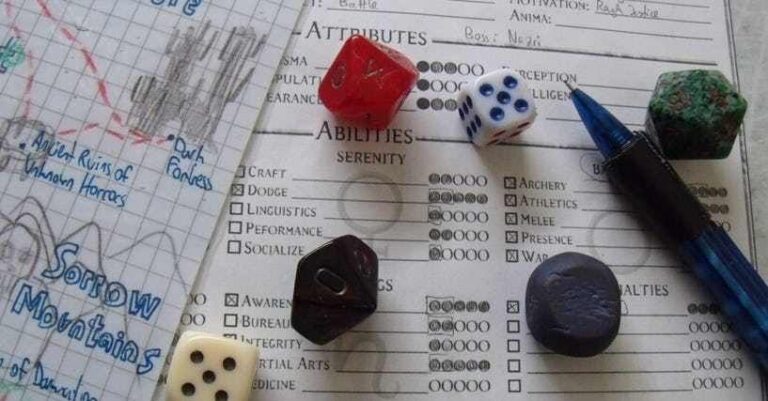Whether you’re diving into a new hobby or looking to expand your tabletop repertoire, creating a solo RPG adventure can be incredibly rewarding. So, how do you craft a compelling experience without a Dungeon Master or party to guide the way?
Start with the Right Tools
When it comes to solo RPGs, having the right resources makes all the difference. One standout option to consider is using My Adventures, an intuitive tool that can guide your storytelling while keeping the experience flexible. It acts as a creative compass, helping you frame narratives, generate ideas, and maintain momentum in your sessions. Whether you’re a seasoned RPG player or a curious newcomer, tools like these are a great starting point.
Beyond that, you’ll also want to gather dice, a good notebook, and perhaps a set of index cards to jot down characters, locations, and plot twists. Many solo RPG systems also have printable resources, so don’t forget to check what’s available for your chosen game.
Choose the Perfect System
The beauty of solo RPGs lies in their versatility. There are systems tailored specifically for solo play, offering streamlined mechanics that don’t require a traditional Game Master. Some fan-favourite options include:
● Ironsworn – A narrative-driven system designed for solo or co-op play, with deep world-building elements.
● Thousand Year Old Vampire – A journaling RPG that immerses you in the life of a vampire spanning centuries.
● Four Against Darkness – A dungeon-crawling adventure perfect for players who enjoy rolling dice and overcoming challenges.
Love storytelling? Opt for something narrative-heavy. Enjoy crunching numbers? A more mechanical system might be a better fit.
Build Your World
Creating a rich and engaging world is one of the joys of solo RPGs. You’re the master of everything, from sprawling cities to eerie forests, so let your imagination run wild. Start by asking yourself a few key questions:
● What’s the tone of your story? Dark and mysterious, or light-hearted and adventurous?
● Where does the adventure take place? Is it a single kingdom, a vast galaxy, or somewhere entirely unique?
● Who inhabits this world? Think about factions, cultures, or even legendary figures.
World-building doesn’t have to be overwhelming. Begin with broad strokes and layer in details as you go. For example, jot down a few major locations and add interesting quirks to make them stand out—a haunted lighthouse or a bustling marketplace known for its quirky traders.
Create Dynamic Characters
Your characters are the heart of your solo RPG. Whether you’re playing as a lone adventurer or controlling a cast of personalities, give them depth by fleshing out their motivations, flaws, and quirks.
Think about their backstory. Why are they on this journey? What do they want to achieve? Conflict and personal stakes add richness to the narrative. If you’re struggling to get started, try rolling for random traits or using character generators to spark ideas.
Additionally, don’t forget about non-player characters (NPCs). A grumpy innkeeper, a mysterious rival, or a loyal animal companion can add layers to your story, making the world feel alive.
Embrace Journaling
Journaling is a cornerstone of solo RPGs, allowing you to document your story while reflecting on your decisions. Keep a dedicated notebook for your game and write down key events, your character’s thoughts, and any surprising twists that unfold.
Some solo RPG systems, like Thousand Year Old Vampire, integrate journaling into the gameplay, making it a natural part of the experience. But even if your chosen system doesn’t, you can add this element yourself.
Keep It Flexible
One of the biggest perks of solo RPGs is their flexibility. There’s no schedule to coordinate, no group dynamics to balance—you can tailor everything to your preferences. If a particular mechanic isn’t clicking for you, tweak it. Want to take a break from dice rolls? Focus on storytelling for a while.
There’s no right or wrong way to play, so lean into what brings you joy.
Use Random Generators for Inspiration
Feeling stuck? Random generators can be your secret weapon. They’re perfect for sparking ideas when your creativity hits a wall. Need a plot twist? Roll on a random event table. Struggling to name your character’s hometown? A name generator has you covered.
Many RPG systems include built-in tables for this purpose, but you can also find free tools online tailored to solo play. Experiment with them to see how they can add unexpected flavour to your sessions.
Don’t Rush the Story
Solo RPGs are about the journey, not just the destination. Take your time exploring the world you’ve created, making decisions that feel meaningful, and letting the narrative unfold naturally.
Unlike group campaigns, there’s no pressure to move at a certain pace. If you want to spend an entire session fleshing out a single town or exploring your character’s backstory, go for it. Let the story breathe—it’ll make your experience all the more memorable.
Add Visual Elements
Want to elevate your solo RPG? Bring your world to life with visual aids. Draw maps of your world, sketch your character, or create mood boards to set the tone. You don’t need to be an artist—simple doodles or collages can be just as effective.
Adding visuals helps ground your imagination and makes the experience feel even more immersive.
Celebrate Your Progress
One of the best parts of solo RPGs is the sense of accomplishment that comes with building something entirely on your own. As your story evolves, take a moment to appreciate how far you’ve come. Whether you’ve crafted a sprawling fantasy epic or a short but impactful tale, it’s worth celebrating.
Make Your Own Adventure
So, gather your dice, sharpen your pencils, and let the adventure begin. The only limit is where your imagination takes you.
